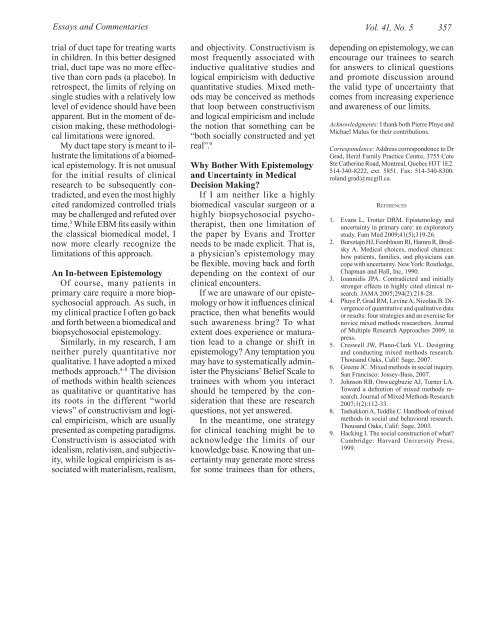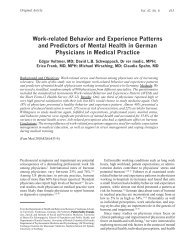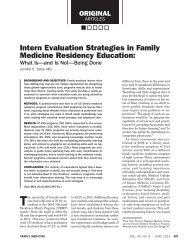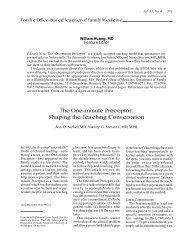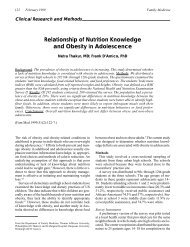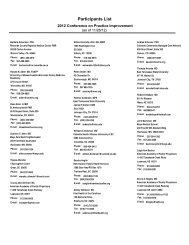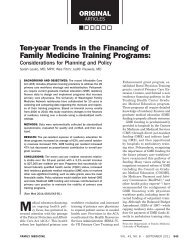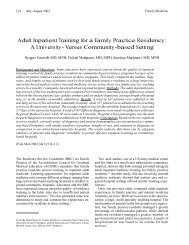What's Your Epistemology? Think About It - STFM
What's Your Epistemology? Think About It - STFM
What's Your Epistemology? Think About It - STFM
You also want an ePaper? Increase the reach of your titles
YUMPU automatically turns print PDFs into web optimized ePapers that Google loves.
Essays and Commentaries<br />
Vol. 41, No. 5<br />
357<br />
trial of duct tape for treating warts<br />
in children. In this better designed<br />
trial, duct tape was no more effective<br />
than corn pads (a placebo). In<br />
retrospect, the limits of relying on<br />
single studies with a relatively low<br />
level of evidence should have been<br />
apparent. But in the moment of decision<br />
making, these methodological<br />
limitations were ignored.<br />
My duct tape story is meant to illustrate<br />
the limitations of a biomedical<br />
epistemology. <strong>It</strong> is not unusual<br />
for the initial results of clinical<br />
research to be subsequently contradicted,<br />
and even the most highly<br />
cited randomized controlled trials<br />
may be challenged and refuted over<br />
time. 3 While EBM fits easily within<br />
the classical biomedical model, I<br />
now more clearly recognize the<br />
limitations of this approach.<br />
An In-between <strong>Epistemology</strong><br />
Of course, many patients in<br />
primary care require a more biopsychosocial<br />
approach. As such, in<br />
my clinical practice I often go back<br />
and forth between a biomedical and<br />
biopsychosocial epistemology.<br />
Similarly, in my research, I am<br />
neither purely quantitative nor<br />
qualitative. I have adopted a mixed<br />
methods approach. 4-8 The division<br />
of methods within health sciences<br />
as qualitative or quantitative has<br />
its roots in the different “world<br />
views” of constructivism and logical<br />
empiricism, which are usually<br />
presented as competing paradigms.<br />
Constructivism is associated with<br />
idealism, relativism, and subjectivity,<br />
while logical empiricism is associated<br />
with materialism, realism,<br />
and objectivity. Constructivism is<br />
most frequently associated with<br />
inductive qualitative studies and<br />
logical empiricism with deductive<br />
quantitative studies. Mixed methods<br />
may be conceived as methods<br />
that loop between constructivism<br />
and logical empiricism and include<br />
the notion that something can be<br />
“both socially constructed and yet<br />
real”. 9<br />
Why Bother With <strong>Epistemology</strong><br />
and Uncertainty in Medical<br />
Decision Making?<br />
If I am neither like a highly<br />
biomedical vascular surgeon or a<br />
highly biopsychosocial psychotherapist,<br />
then one limitation of<br />
the paper by Evans and Trotter<br />
needs to be made explicit. That is,<br />
a physician’s epistemology may<br />
be flexible, moving back and forth<br />
depending on the context of our<br />
clinical encounters.<br />
If we are unaware of our epistemology<br />
or how it influences clinical<br />
practice, then what benefits would<br />
such awareness bring? To what<br />
extent does experience or maturation<br />
lead to a change or shift in<br />
epistemology? Any temptation you<br />
may have to systematically administer<br />
the Physicians’ Belief Scale to<br />
trainees with whom you interact<br />
should be tempered by the consideration<br />
that these are research<br />
questions, not yet answered.<br />
In the meantime, one strategy<br />
for clinical teaching might be to<br />
acknowledge the limits of our<br />
knowledge base. Knowing that uncertainty<br />
may generate more stress<br />
for some trainees than for others,<br />
depending on epistemology, we can<br />
encourage our trainees to search<br />
for answers to clinical questions<br />
and promote discussion around<br />
the valid type of uncertainty that<br />
comes from increasing experience<br />
and awareness of our limits.<br />
Acknowledgments: I thank both Pierre Pluye and<br />
Michael Malus for their contributions.<br />
Correspondence: Address correspondence to Dr<br />
Grad, Herzl Family Practice Centre, 3755 Cote<br />
Ste Catherine Road, Montreal, Quebec H3T 1E2.<br />
514-340-8222, ext. 5851. Fax: 514-340-8300.<br />
roland.grad@mcgill.ca.<br />
Re f e r e n c e s<br />
1. Evans L, Trotter DRM. <strong>Epistemology</strong> and<br />
uncertainty in primary care: an exploratory<br />
study. Fam Med 2009;41(5);319-26.<br />
2. Bursztajn HJ, Feinbloom RI, Hamm R, Brodsky<br />
A. Medical choices, medical chances:<br />
how patients, families, and physicians can<br />
cope with uncertainty. New York: Routledge,<br />
Chapman and Hall, Inc, 1990.<br />
3. Ioannidis JPA. Contradicted and initially<br />
stronger effects in highly cited clinical research.<br />
JAMA 2005;294(2):218-28.<br />
4. Pluye P, Grad RM, Levine A, Nicolau B. Divergence<br />
of quantitative and qualitative data<br />
or results: four strategies and an exercise for<br />
novice mixed methods researchers. Journal<br />
of Multiple Research Approaches 2009, in<br />
press.<br />
5. Creswell JW, Plano-Clark VL. Designing<br />
and conducting mixed methods research.<br />
Thousand Oaks, Calif: Sage, 2007.<br />
6. Greene JC. Mixed methods in social inquiry.<br />
San Francisco: Jossey-Bass, 2007.<br />
7. Johnson RB, Onwuegbuzie AJ, Turner LA.<br />
Toward a definition of mixed methods research.<br />
Journal of Mixed Methods Research<br />
2007;1(2):112-33.<br />
8. Tashakkori A, Teddlie C. Handbook of mixed<br />
methods in social and behavioral research.<br />
Thousand Oaks, Calif: Sage, 2003.<br />
9. Hacking I. The social construction of what?<br />
Cambridge: Harvard University Press,<br />
1999.


